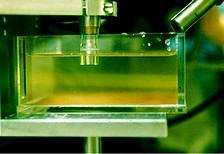
|
| ©Unknown |
Ramat-Gan - Bar-Ilan University scientists have developed a way to detect and measure contamination in a body of water by "listening" to the sound that microscopic algae plants release into it. The technology, described as "revolutionary," was developed by Prof. Zvy Dubinsky and Dr. Yulia Pinchasov of the Bar-Ilan Goodman life sciences faculty and was recently published in a number of scientific journals, including the prestigious Hydrobiological Journal.
The method is based on the analysis of the rate of photosynthesis (the process of converting sunlight into energy) of plants growing in the water. The researchers examined whether the plants realized their full photosynthesis potential and if not, this served as a signal that something was wrong within the growth environment.
The new technology radiates a green laser beam on the plant being examined, which, if the plant is reaching its full photosynthesis potential, will utilize part of the laser light and convert it into energy, while the rest is converted into heat. This heat causes the water to expand and produces a change in pressure, which is actually a sound wave that can be picked up by a hydrophone or a special aquatic microphone.
Based on the quantity of light energy that is converted into heat and sound, researchers can calculate the remainder that has been absorbed by the plant, and thus learn of its condition.
A plant suffering from lead poisoning for example, which comes from waste released by battery and paint manufacturing plants into water sources, will produce a different resonance than that of a healthy plant. The method enables the early detection of penetrating contaminants and toxins that harm flora and fauna.
This improved method of detection is crucial, as the country's dwindling supply of drinking water needs to be constantly monitored to detect contamination and any decline in quality.
The method will replace more outdated measurement methods such as marking a plant's growth substrate with radioactive carbon or measuring the quantities of oxygen emitted by the plant. The new method is more effective than previously used methods in identifying the source of the contamination.



Reader Comments
to our Newsletter